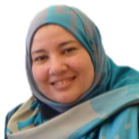
Noura A. Semary
Work place: Faculty of Computers and Information, Menofia University, Menofia, Egypt
E-mail: noura.samri@ci.menofia.edu.eg
Website:
Research Interests: Computer Vision, 2D Computer Graphics, Computer Animation, Data Compression, Data Structures and Algorithms
Biography
Noura A. Semary works as an associated prof. in Faculty of Computers and Information, Menofia University, Egypt. She has BSc in 2001 from Cairo University, Faculty of Computers and Information. She worked as a staff member in the Faculty of Computers and Information, Menofia University, Egypt in 2003. In 2007 and 2011 she has obtained her Master and Ph.D. degrees respectively in Information Technology from Computers and Information Faculty at Menofia University. Her main research interests are in Image Processing, Computer Vision, Data Compression, Data Hiding, Virtual Reality and Assistive Technology fields. In 2009 she won the first rank in “Made in Egypt” and “Made in Arab World” competitions for her project “Black and White Movies Colorizer”. In 2012 she has joined The Scientific Research Group in Egypt (SRGE). She has 25 publications in international conferences and journals. Also, she has reviewed more than 10 papers for international conferences and journals in 2014. She is also leading and supervising various graduation projects and post-graduate students.
Author Articles
Local Detectors and Descriptors for Object Class Recognition
By Faten A. Khalifa Noura A. Semary Hatem M. El-Sayed Mohiy M. Hadhoud
DOI: https://doi.org/10.5815/ijisa.2015.10.02, Pub. Date: 8 Sep. 2015
Local feature detection and description are widely used for object recognition such as augmented reality applications. There have been a number of evaluations and comparisons between feature detectors and descriptors and between their different implementations. Those evaluations are carried out on random sets of image structures. However, feature detectors and descriptors respond differently depending on the image structure. In this paper, we evaluate the overall performance of the most efficient detectors and descriptors in terms of speed and efficiency. The evaluation is carried out on a set of images of different object classes and structures with different geometric and photometric deformations. This evaluation would be useful for detecting the most suitable detector and descriptor for a particular object recognition application. Moreover, multi-object applications such as digilog books could change the detector and descriptor used based on the current object. From the results, it has been observed that some detectors perform better with certain object classes. Differences in performance of the descriptors vary with different image structures.
[...] Read more.Other Articles
Subscribe to receive issue release notifications and newsletters from MECS Press journals